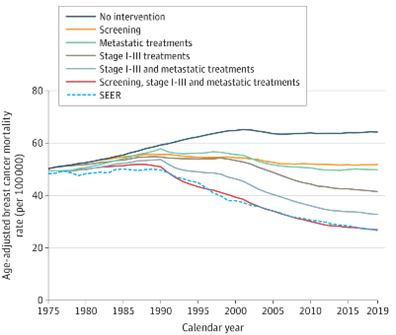Recent Highlights: Breast
CISNET models help explain why breast cancer mortality has declined since 1975
In this recent analysis published in JAMA, four CISNET models were used to estimate the contribution to the reduction in breast cancer mortality of changes in breast cancer screening and treatment since 1975. Across the models, of the 58% reduction in breast cancer mortality with the interventions that have been introduced since the 1970s, 29% of it was estimated to be because of treatment of metastatic breast cancer, 47% treatment of stage I-III breast cancer, and 25% mammography screening.
This analysis is the third in a series of comparative modeling analyses by the CISNET Breast Working Group that have examined the cumulative impact of screening and treatment on breast cancer mortality since 1975 during the periods 1975-2000 (published in 2005), 2000-2012 (published in 2018) , and 2012 to 2019 (published in 2024) respectively. Taken together these papers represented three eras in cancer treatment advances, from early developments of multiple agent chemotherapy and hormonal therapy, to the introduction of targeted therapy, to more rapid advances in the treatment of metastatic disease (especially for ERBB2+ patients). During this time, mammography also transitioned from film to digital to tomosynthesis (3D mammography). Feedback loops based on understanding the past impact of cancer control interventions are necessary to help optimize the future cancer research enterprise.
Analysis of Breast Cancer Mortality in the US-1975 to 2019.

Analysis of Breast Cancer Mortality in the US-1975 to 2019. Caswell-Jin JL, Sun LP, Munoz D, Lu Y, Li Y, Huang H, Hampton JM, Song J, Jayasekera J, Schechter C, Alagoz O, Stout NK, Trentham-Dietz A, Lee SJ, Huang X, Mandelblatt JS, Berry DA, Kurian AW, Plevritis SK. JAMA. 2024 Jan 16;331(3):233-241. doi: 10.1001/jama.2023.25881. PMID: 38227031